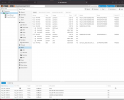Hi All,
Bit of an issue here. I performed an upgrade via the GUI yesterday but upon rebooting the system I now get:
Loading Linux 5.11.22-3-pve ...
issue: error: file 'vmlinuz-5.11.22-3-pve' not found
Loading initial ramdisk ...
error: you need to load the kernel first.
Press any key to continue...
If I select advanced options I get two options:
Proxmox VE GNU/Linux, with Linux 5.11.22-3-pve
Proxmox VE GNU/Linux, with Linux 5.11.22-1-pve
If I select the first option I get the error above, if I select the second I get a few ACPI BIOS errors (bug) which I think are to do with the intel protection and then:
Found volume group "SSD" using metadata type lvm2
Found volume group "pve" using metadata type lvm2
3 logical volume(s) in volume group "SSD" now active
4 logical volume(s) in volume group "pve" now active
Command: /sbin/zpool import -N 'rpool'
Message: cannot import 'pool' : pool was previously in use from another system.
Last accessed by Proxy (hosted-bf41c0aa) at Sun Aug 8 23:00:18 2021
The pool can be imported, use 'zpool import -f' to import the pool.
Error: 1
Failed to import pool 'rpool'.
Manually import the pool and exit.
BusyBox v1.30.1 (Debian 1:1.30.1-6+b2) built-in shell (ash)
(initramfs)
What have I done?
How do I start troubleshooting this?
Regards,
Scott
Bit of an issue here. I performed an upgrade via the GUI yesterday but upon rebooting the system I now get:
Loading Linux 5.11.22-3-pve ...
issue: error: file 'vmlinuz-5.11.22-3-pve' not found
Loading initial ramdisk ...
error: you need to load the kernel first.
Press any key to continue...
If I select advanced options I get two options:
Proxmox VE GNU/Linux, with Linux 5.11.22-3-pve
Proxmox VE GNU/Linux, with Linux 5.11.22-1-pve
If I select the first option I get the error above, if I select the second I get a few ACPI BIOS errors (bug) which I think are to do with the intel protection and then:
Found volume group "SSD" using metadata type lvm2
Found volume group "pve" using metadata type lvm2
3 logical volume(s) in volume group "SSD" now active
4 logical volume(s) in volume group "pve" now active
Command: /sbin/zpool import -N 'rpool'
Message: cannot import 'pool' : pool was previously in use from another system.
Last accessed by Proxy (hosted-bf41c0aa) at Sun Aug 8 23:00:18 2021
The pool can be imported, use 'zpool import -f' to import the pool.
Error: 1
Failed to import pool 'rpool'.
Manually import the pool and exit.
BusyBox v1.30.1 (Debian 1:1.30.1-6+b2) built-in shell (ash)
(initramfs)
What have I done?
How do I start troubleshooting this?
Regards,
Scott


